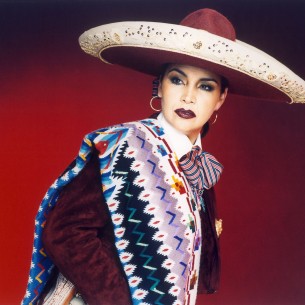By Catalina Maria Johnson
There may be perhaps no music as iconic of Mexico as the mariachi: a large ensemble of musiciansin bejeweled suits and large hats in the tradtional horseman or charro tradition, playing music that is a staple at any family and civic celebration.
The city of Chicago’s Mexican and Mexican-American population has a long-standing love and its own renowned history of mariachi traditions, and this Sunday, 3:00, at the Harris Theater, Latin Grammy award winner, Aida Cuevas and José Hernandez’s Mariachi Sol de México will perform at a Mariachi Heritage Foundation benefit concert to support Chicago’s first standards-based student mariachi music program. The foundation’s mission is to expand mariachi music education programs in Chicago’s public school system, and the K-12 grade student program will permit students to meet their music requirements through a structured curriculum in mariachi performance as part of the regular school day.
The importance of mariachi music in Mexican and Mexican-American culture goes back to its deep roots in the history of the land. The art form was born in a city named Cocula, Jalisco, and one likely theory is that the word “mariachi” evolved from songs by the Coca indigenous people who lived in that city. These people worshipped a Virgin called María del Río, and mixing the languages of Spanish, Nahuatl and Latin, would sing “María I love you”, which sounded like ”maria-shi”.
Just like the origins of its name, the art is witness and testament to the Mexico’s mestizo or mixed culture. In the complete mariachi group today there are as many as six to eight violins, two trumpets, and a guitar – all standard European instruments. Then there is a high-pitched, round-backed guitar called the vihuela, which gives the mariachi its rhythmic vitality; a deep-voiced guitar called the guitarrón which serves as the bass; and a Mexican folk harp, which also ornaments the melody. These last three instruments have European origins, but in their present form are strictly Mexican.
The principal music played in particular by early Mariachis was the son, a mixture of folk traditions from Spain, Mexico, and Africa, which is found in different regiosn of Mexico. Sunday’s concert will also feature Chicago’s acclaimed Sones de México Ensemble, who have for well over fifteen years preserved as well as created new sones, Chicago-style.
However, Mariachi music is also music to for dancing, not just playing and singing. The traditional dance technique associated associated with mariachi is the percussive footwork called the zapateado, where dancers pound out rapid, syncopated rhythms, and on Sunday, the Mexican Folkloric Dance Company of Chicago will also perform to add this essential element of Mariachi culture to the concert.

